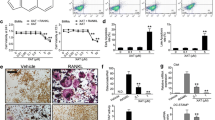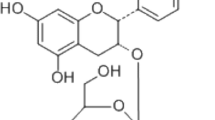Abstract
Anoectochilus formosanus, a plant native to Taiwan, is used as a folk medicine. It was found that oral administration of A. formosanus extract (AFE) (500 mg/kg) for 4 weeks suppressed bone weight loss and trabecular bone loss in ovariectomized mice, an experimental model of osteoporosis. Although AFE at 12.5 and 25 μg/ml inhibited osteoclast formation in co-culture of osteoblasts and bone marrow cells, AFE did not inhibit the formation of osteoclast progenitor cells and preosteoclast cells in bone marrow cells and RAW264 cells. However, AFE (at 12.5 and 25 μg/ml) decreased RANKL expression. These results suggested that AFE might suppress the bone loss caused by estrogen deficiency through suppression of RANKL expression required for osteoclast formation.
Similar content being viewed by others
References
Arnaud CD, Kolb FO (1986) The calcitropic hormones and metabolic bone disease. In: Basic & Clinical Endocrinology. Lange, Los Altos, pp 202–271
Lin CC, Huang PC, Lin JM (2000) Antioxidant and hepatoprotective effects of Anoectochilus formosanus and Gynostema pentaphyllum. Am J Chin Med 28:87–96
Shih CC, Wu YW, Lin WJ (2002) Antihyperblycemic and antioxidant properties of Anoectochilus formosanus in diabetic rats. Clin Exp Pharmacol Physiol 29:684–688
Lin JM, Lin CC, Chiu H (1993) Evaluation of the anti-inflammatory and liver protective effects of Anoectochilus formosanus, Ganoderma lucidum, and Gynostemma pentaphillum in rats. Am J Chin Med 21:59–69
Shih CC, Wu YW, Lin WC (2001) Ameliorative effects of Anoectochilus formosanus extract on osteopenia in ovariectomized rats. J Ethnopharmacol 77:233–238
Yamaguchi K, Hayama T, Makita T, Tsuji T (1997) Time course of bone biomechanical parameters in ovariectomized mice. J Bone Miner Metab 15:138–144
Baron R (1989) Molecular mechanisms of bone resorption by the osteoclast. Anat Rec 224:317–324
Suda T, Takahashi N, Martin TJ (1992) Modulation of osteoclast differentiation. Endocr Rev 13:66–80
Miura M, Tanaka K, Komatsu Y, Suda M, Yasuda A, Sakuma Y, Ozasa A, Nakao K (2002) A novel interaction between thyroid hormones and 1,25(OH)(2)D(3) in osteoclast formation. Biochem Biophys Res Commun 291:987–994
Hsu H, Lacey D, Dunstan CR, Solovyev I, Colombero A, et al (1999) Tumor necrosis factor receptor family member RANK mediates osteoclast differentiation and activation induced by osteoprotegerin ligand. Proc Natl Acad Sci USA 96:3540–3545
Jimi E, Akiyama S, Tsurukai T, Okahashi N, Kobayashi K, Udagawa N, Nishihara T, Takahashi N, Suda T (1999) Osteoclast differentiation factor acts as a multifunctional regulator in murine osteoclast differentiation and function. J Immunol 163:434–442
Yamaguchi K, Yada M, Tsuji T, Kuramoto M, Uemura D (1999) Suppressive effect of norzoanthamine hydrochloride on experimental osteoporosis in ovariectomized mice. Biol Pharm Bull 22: 920–924
Parfitt AM, Mathews CHE, Villanueva AR, Kleerekoper M (1983) Relationships between surface, volume, and thickness of iliac trabecular bone in aging and osteoporosis. J Clin Invest 72: 1396–1409
Kodama H, Nose M, Niida S, Yamazaki A (1991) Essential role of macrophage colony-stimulating factor in the osteoclast differentiation supported by stromal cells. J Exp Med 173:1291–1294
Kodama H, Yamazaki A, Nose M, Niida S, Ohgame Y, Abe M, Kumegawa M, Suda T (1991) Congenital osteoclast deficiency in osteopetrotic (op/op) mice is cured by injenctions of macrophage colony-stimulating factor. J Exp Med 173:269–272
Takahashi N, Udagawa N, Suda T (1998) A new member of tumor necrosis factor ligand family, ODF/OPGL/TRANCE/RANKL, regulates osteoclast differentiation and function. J Biol Chem 273: 27091–27096
Itonaga I, Sabokbar A, Sun SG, Kudo O, Danks L, Ferguson D, Fujikawa Y, Athanasou NA (2004) Transforming growth factor-β induces osteoclast formation in the absence of RANKL. Bone (NY) 34:57–64
Quinn JM, Elliott J, Gillespie MT, Martin TJ (1998) A combination of osteoclast differentiation factor and macrophage colony-stimulating factor is sufficient for both human and mouse osteoclast formation in vitro. Endocrinology 139:4424–4427
Gyda M, Corisdeo S, Zaidi M, Troen BR (2001) Macrophage colony-stimulating factor suppress osteoblast formation. Biochem Biophys Res 285:328–334
Nakagawa N, Kinosaki M, Tamaguchi K, Shima N, Yasuda H, Yano K, Morinaga T, Higashio K (1998) RANK is the essential signaling receptor for osteoclast differentiation factor in osteoclastgenesis. Biochem Biophys Res Commun 253:395–400
Fuller K, Wong B, Fox S, Choi Y, Chambers TJ (1998) TRANCE is necessary and sufficient for osteoblast-medicated activation of bone resorption in osteoclasts. J Exp Med 188:997–1001
Woo JT, Nakagawa H, Kotoya M, Yonezawa T, Udagawa N, Lee IS, Ohnishi M, Hagiwara H, Nagai K (2004) Quercetin suppress bone resorption by inhibiting the differentiation and activation of osteoclasts. Biol Pharm Bull 27:504–509
Uchiyama S, Yamaguchi M (2004) Inhibitory effect of β-cryptoxanthin on osteoclast—like cell formation in mouse marrow cultures. Biochem Pharm 67:1297–1305
Author information
Authors and Affiliations
Corresponding author
About this article
Cite this article
Masuda, K., Ikeuchi, M., Koyama, T. et al. Suppressive effects of Anoectochilus formosanus extract on osteoclast formation in vitro and bone resorption in vivo. J Bone Miner Metab 26, 123–129 (2008). https://doi.org/10.1007/s00774-007-0810-8
Received:
Accepted:
Published:
Issue Date:
DOI: https://doi.org/10.1007/s00774-007-0810-8




